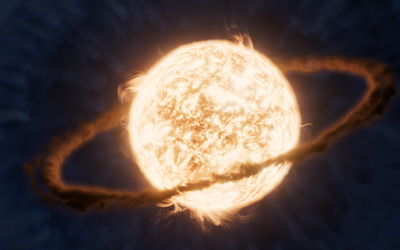Topics
![]() Earth Science
Earth Science
![]() Solar Systems
Solar Systems
![]() Stars & Nebulae
Stars & Nebulae
![]() Cosmology
Cosmology
Dying Stars’ Final Artwork
One of the justifications for building the Hubble Space Telescope was to finally get a detailed enough view of the fuzzy blobs we call planetary nebulae that we could finally understand what is going on. Turns out, for some of the nebulae, we actually needed...
It’s a Star-Eat-Planet Universe
One of the most mystifying planets to many of us are the hot Jupiters. These massive worlds have orbits smaller than Mercury’s and in some cases are so close to their stars that starlight is pushing mass off the planet or the planet is raising tides on the star....
New Weird Star-Star-Planet Combination
The Universe sometimes likes to mock us. Such is the case with exoplanets. Once upon a time, researchers would sagely say, “Solar Systems like Tatooine, with twin stars, likely don’t exist.” The thing is, this was based on models that relied on limits created with...
Explore Our Other Shows
Want more content or just something a little different?
We got you! Check out our sister shows.
& Join Our Communities
 Hear myriad voices from the astronomy community in this audio anthology.
Hear myriad voices from the astronomy community in this audio anthology. Learn not just what we know, but how we know it about our universe.
Learn not just what we know, but how we know it about our universe. Un podcast en español de cosmología y astronomía.
Un podcast en español de cosmología y astronomía.
Rubin Observatory Brings Much Needed Joy
Ok, so we held off running this last little section while I waited to see if Vera Rubin observatory would put out a First Light press release. Rubin Observatory did not put out a first light press release. They put out a Facebook post saying “on-sky engineering tests...

Closer Look: The List of Canceled Projects Keeps Growing
After writing that last section, I took a break, I ate some edamame, and I scanned BlueSky, and I learned the story I now need to write is somehow even more depressing than it was 30 minutes ago. There are a lot of articles out there on the missions that may be...

It’s Time to Give Up on Supersymmetry
Since I was old enough to read about particle physics, I’ve been reading about how one possible set of solutions to explain why we have the particles we have in our universe would require the existence of a massive zoo of particles that that bring the population of...

Closer Look: Remote sensing our Planet Earth
We live on a geologically active rocky world that is uniquely shaped by a combination of water-driven weather and complex life. Currently, we are the only world we know of capable of supporting humans without requiring advanced technologies and mitigation against...
Get an Ad-Free Experience by Joining our Patreon.

Galaxies Seen Through Gas
One of the more surreal aspects of JWST images is that infrared light can pass through a lot of dust and gas, allowing us to see galaxies that were previously hidden. New images of Herbig-Haro 49/50 resemble a weirdly abstract Christmas tree; a ring galaxy ornaments...
Catch us on YouTube
New episodes every other Wednesday
Patrons get all content early!
Check us out, drop a sub,
and get notified when we release
all that is new in space and astronomy.
Access Premium Content
Join our Patreon for Early Access to Episodes, Patreon only content, and Much More!
Follow Us
Find us where you are and get notified of all that is new around CosmoQuest and our shows like EVSN.



